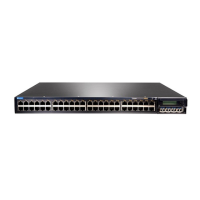When connecting uplink module ports, you can install an SFP uplink module at one end
of the connection and install an SFP+ uplink module configured to operate in the 1-gigabit
mode at the other end. Likewise, you can install an XFP uplink module at one end of the
connection and install an SFP+ uplink module configured to operate in the 10-gigabit
mode at the other end.
This topic describes:
•
SFP Uplink Module on page 16
•
SFP+ Uplink Module and SFP+ MACsec Uplink Module on page 16
•
XFP Uplink Module on page 18
SFP Uplink Module
Figure 5 on page 16 shows the SFP uplink module, which provides four ports for 1-gigabit
SFP transceivers.
Figure 5: SFP Uplink Module
SFP uplink modules are shipped with dust covers preinstalled in the ports.
The SFP uplink module requires Junos OS for EX Series switches, Release 9.0 or later.
SFP+ Uplink Module and SFP+ MACsec Uplink Module
The SFP+ uplink module and the SFP+ MACsec uplink module can be used for either
SFP+ or SFP transceivers. You configure the operating mode on the module to match
the type of transceiver you want to use—for SFP+ transceivers,you configure the 10-gigabit
operating mode, and for SFP transceivers, you configure the 1-gigabit operating mode.
See Setting the Mode on an SFP+ or SFP+ MACSec Uplink Module (CLI Procedure).
By default, the SFP+ uplink module and the SFP+ MACsec uplink module operate in the
10-gigabitmode and support onlySFP+ transceivers. If you have notchangedthe module
from the default setting and you want to use SFP+ transceivers, you do not need to
configure the operating mode.
Copyright © 2016, Juniper Networks, Inc.16
EX3200 Switch Hardware Guide

